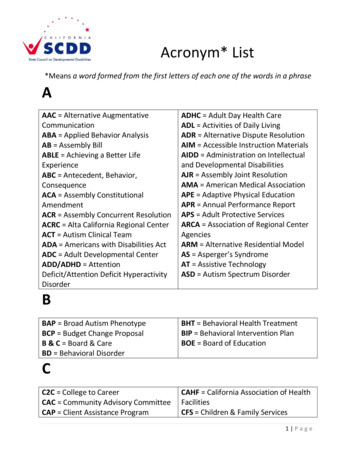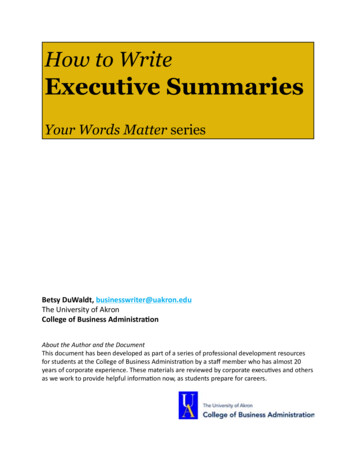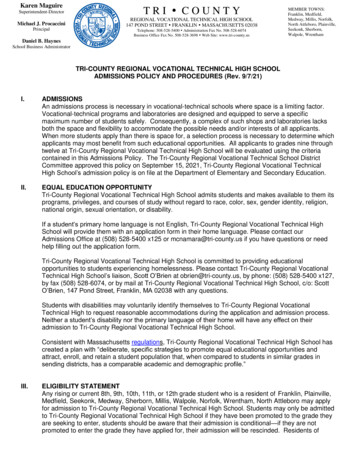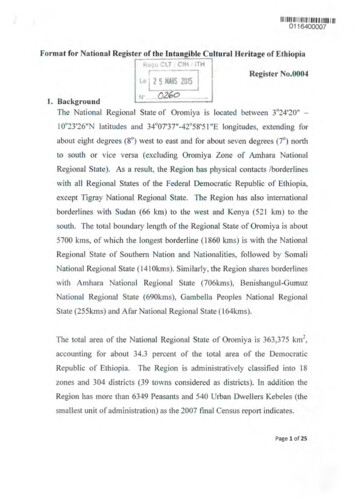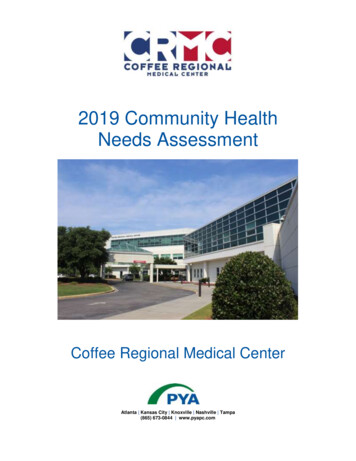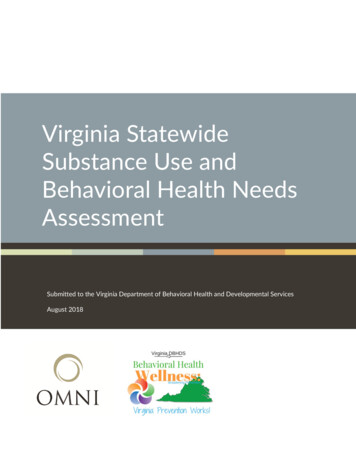
Transcription
001636 NO56 01-B2262Niagara CountyComprehensive EmergencyManagement PlanUpdate: June 2007Prepared for:COUNTY OF NIAGARAPrepared by:ECOLOGY AND ENVIRONMENT, INC.368 Pleasant View DriveLancaster, New York 14086
Table of ContentsSectionPageExecutive Summary. 11General Considerations and Planning Guidelines . 1-11.11.21.31.41.51.61.72Niagara County. 1-1Purpose and Objectives of the CEMP . 1-2Elements of the CEMP . 1-51.3.1 Prevention and Mitigation (Risk Reduction). 1-51.3.2 Response. 1-51.3.3 Recovery. 1-7Legal Authority. 1-8National Response Plan (NRP) . 1-8National Incident Management System (NIMS) . 1-9Concept of Operations: A Tiered Response . 1-10Preparedness, Prevention, and Mitigation. 2-12.1Roles and Responsibilities . 2-12.1.1 Role of the Niagara County Director of Emergency Management. 2-12.1.2 Role of the Niagara County Hazard Mitigation Planning Team . 2-22.1.3 Role of the Niagara County Critical Infrastructure Protection andRisk Management Team. 2-32.1.4 Role of the Niagara County Local Emergency PlanningCommittee (LEPC). 2-32.2 Identification and Analysis of Potential Hazards . 2-42.3 Risk Reduction Policies, Programs and Reports . 2-52.3.1 Identification and Development of Risk Reduction Policies,Programs and Reports . 2-52.4 Implementing Risk Reduction Policies, Programs and Reports. 2-72.5 Measuring the Ability to Prevent, Respond and Recover . 2-72.6 Monitoring Identified Hazard Areas . 2-82.7 Training . 2-92.8 Exercises. 2-112.9 Public Education and Awareness . 2-122.10 CEMP Review and Updates . 2-133Disaster Response. 3-102:001636 NO56 01-B2262DRAFT - Niagara County CEMP.doc-11/07/07iii
Table of Contents .113.123.133.144Responsibilities . 3-13.1.1 General . 3-13.1.2 Department Responsibilities . 3-13.1.3 Chairman of County Legislature . 3-13.1.4 County Manager . 3-23.1.5 Director of Emergency Management. 3-23.1.6 Succession . 3-3Emergency Response Operations . 3-3Command and Management. 3-43.3.1 Incident Command System (ICS). 3-43.3.2 Mutual Aid . 3-63.3.3 Public Information Systems . 3-6Incident Command Post and Emergency Operations Center . 3-73.4.1 Incident Command Post . 3-73.4.2 Emergency Operations Center. 3-7Identification and Notification . 3-11Declaration of Local State of Emergency and Promulgation of LocalEmergency Orders . 3-11Communication and Information Management. 3-123.7.1 Emergency Communications. 3-123.7.2 Public Information Officer . 3-14Protective Actions . 3-153.8.1 Evacuation . 3-153.8.2 In-Place Sheltering . 3-183.8.3 Emergency Procedures for Agriculture and Livestock. 3-183.8.4 Isolation and Quarantine. 3-19Emergency Medical Assistance and Public Health . 3-19Meeting Human Needs . 3-19Special Needs Populations . 3-20Restoring Public Services. 3-20Resource Management . 3-21Standard Operating Guidelines . 3-22Disaster Recovery. 4-14.14.2Documentation of Expenses. 4-1Damage Assessment. 4-14.2.1 Responsibilities . 4-14.2.2 Damage Assessment Team. 4-24.2.3 Pre-emergency Activities . 4-24.2.4 Emergency Activities . 4-34.2.5 Post-emergency Activities. 4-34.2.6 Damage Assessment. 4-44.2.6.1 Director of Emergency Management . 4-44.2.6.2 Authorized Agent. 4-54.2.6.3 Damage Assessment Reports . 4-602:001636 NO56 01-B2262DRAFT - Niagara County CEMP.doc-11/07/07iv
Table of Contents (cont.)SectionPage4.34.44.54.6Planning for Recovery. 4-7Recovery and Redevelopment Plan. 4-7Reconstruction. 4-9Public Information on Recovery Assistance . 4-10AppendixASpecific Powers and Authorities . A-1BResolution: CEMP Adoption . B-1CEmergency Exercises . C-1DCEMP Review and Updates. D-1ECEMP Distribution List .E-1FEmergency Response Functions/Emergency SupportServices .F-1GSuccession Procedures . G-1HStandard Operating Procedures . H-1ISample Damage Assessment Form. I-1JExercise Documentation . J-1Annexes*Alert ListBio TerrorismCritical Infrastructure Identified and Associated LossDam Failure Emergency PlansDraft Cross Border Contingency PlanEmergency Communications PlanEquipment and Apparatus Resource List: Police, Fire, and Emergency PersonnelHazardous Material Response Plan: Title IIIListing of Other Site Specific Emergency PlansMass Evacuation Management Plan02:001636 NO56 01-B2262DRAFT - Niagara County CEMP.doc-11/07/07v
Table of Contents (cont.)SectionPageMulti-jurisdictional Hazard Mitigation PlanNiagara County Fire Mutual Aid PlanNiagara County Power ProjectPublic Health Emergency Preparedness and Response PlanRadiological Protection PlanSchool Emergency PlansSheltering and Mass Care PlanSpecial Needs PlanTerrorism Response PlanTransportation* Annexes are on file with the Niagara County Emergency Management Office02:001636 NO56 01-B2262DRAFT - Niagara County CEMP.doc-11/07/07vi
List of TablesTablePageTable 1-1 2000 Niagara County Populations: Cities, Towns, and Villages . 1-1Table 2-1 Niagara County NIMS Compliance Training Matrix . 2-1002:001636 NO56 01-B2262DRAFT - Niagara County CEMP.doc-11/07/07vii
List of FiguresFigurePage1-1Map of Niagara County. 1-33-1National Incident Management-Incident Command System OrganizationModel . 3-502:001636 NO56 01-B2262DRAFT - Niagara County CEMP.doc-11/07/07ix
List of Abbreviations and AcronymsCANCommunity Alert NetworkCEMPComprehensive Emergency Management PlanCOOGContinuity of GovernmentDACDisaster Assistance CenterDPCDisaster Preparedness Commission, N.Y. StateEBSEmergency Broadcast SystemEMSemergency medical servicesEOCEmergency Operations CenterEPIEmergency Public InformationESFEmergency Support FunctionFEMAFederal Emergency Management AgencyHAZNYHazards New York (computer software)HMPHazard Mitigation PlanHSPDHomeland Security Presidential DirectiveICIncident CommanderICSIncident Command SystemLEPCNiagara County Local Emergency Planning CommitteeNAWASNational Warning SystemNIMSNational Incident Management SystemNRPNational Response PlanNWSNational Weather Service, a part of NOAA02:001636 NO56 01-B2262DRAFT - Niagara County CEMP.doc-11/07/07xi
List of Abbreviations and Acronyms (cont.)OFPCNew York State Office of Fire Prevention and ControlPICPublic Information CenterPIOPublic Information OfficerPSTFPublic Safety Training FacilityRACESRadio Amateur Civil Emergency ServicesRRTRegional Response TeamsSARASuperfund Amendments and Reauthorization ActSEMOState Emergency Management Office (New York)SOGStandard Operating Guideline02:001636 NO56 01-B2262DRAFT - Niagara County CEMP.doc-11/07/07xii
Executive SummaryIntroductionThe Niagara County Comprehensive Emergency Management Plan(CEMP) is intended to provide general all-hazards emergencymanagement guidance. Using existing organizations and lines ofauthority it provides a framework to help the county meet its responsibilities to prevent, protect against, respond to, and recoverfrom emergency events. It outlines the policies, procedures, andcapabilities, which may be required to coordinate the effective response by an appropriate combination of federal, state, local, tribal,nongovernmental, and/or private sector entities in order to savelives and minimize damage, and provide the basis for long-termcommunity recovery and mitigation activities. However, theCEMP is not just a document or plan, but an ongoing process. Thecounty is committed to reviewing and improving the CEMP on anannual basis in order to better protect the citizens who will rely onit.Comprehensive ApproachThe CEMP was prepared by county officials working cooperativelywith state, federal, and private agencies in a planning effort coordinated by the New York State Emergency Management Office(SEMO). The Niagara County CEMP constitutes an integral partof a statewide emergency management program. Both Article 2-Bof the State Executive Law and the New York State DefenseEmergency Act authorized its development. The purpose of theplan is to minimize or prevent the impacts of disasters and to enhance the efficiency of response and recovery operations withinNiagara County. A comprehensive approach to emergency management has been adopted emphasizing the interrelationship of activities, functions, and expertise necessary to deal with emergencies. The plan outlines the actions to be taken by the county beforeduring and after emergencies and is divided according to three major components of emergency management. These components aredisaster prevention and mitigation, response, and recovery.02:001636 NO56 01-B2262DRAFT - Niagara County CEMP.doc-11/07/071
Executive SummaryThe development of this plan included an analysis of potential hazards that could affect the county and an assessment of the capabilities existing in the county to deal with potential hazards.County responsibilities are closely related to the responsibility ofthe local levels of government within the County (i.e., cities,towns, and villages) to manage all phases of an emergency. TheCounty has the responsibility to assist the local governments in theevent that they have fully committed their resources and are stillunable to cope with any disaster.This plan describes in detail the centralized direction of requestsfor assistance and the understanding that the governmental jurisdiction most affected by an emergency is required to fully involve itself in the emergency prior to requesting assistance.Specific emergency management guidance for situations requiringspecial knowledge, technical expertise, and resources is included inseparate annexes attached to the plan.Management ResponsibilitiesCounty departments’ and agencies’ emergency management responsibilities are outlined in this plan. Assignments are madewithin the framework of the present County capability and existingorganizational responsibilities. The Niagara County EmergencyManagement Office is designated to coordinate all emergencymanagement activities of the County.Niagara County has designated the use of the National IncidentManagement Systems (NIMS) as the basis for all incident management in the County of Niagara (Niagara County Legislature,resolution no. CSS-039-05, June 21, 2005). The NIMS is a management tool for the command, control, and coordination of resources and personnel in an emergency.ConclusionThe Niagara County CEMP is intended to provide general all hazards management guidance, using existing organizations and linesof authority to allow the county to meet its responsibilities before,during, and after an emergency occurs. It is a document that outlines the policies, procedures, and assets necessary for the Countyto be prepared for probable and potential threats to its security.However, the CEMP is not just a document or plan, but an ongoingprocess. The County is committed to reviewing and improving theCEMP on an annual basis in order to better protect the citizenswho will rely on it.02:001636 NO56 01-B2262DRAFT - Niagara County CEMP.doc-11/07/072
1General Considerations andPlanning Guidelines1.1 Niagara CountyNiagara County is located in the northwest corner of New YorkState and is bordered by Lake Ontario to the north and the NiagaraRiver to the west. The county is uniquely situated along the UnitedStates-Canadian border. The geographic boundaries of NiagaraCounty encompass nearly 523 square miles (see Figure 1-1). Themost recent census data available indicates that 219,846 peoplecurrently reside within the County. Six percent of the population is5 years old or under, while 15% of the County’s total population is65 years old or older. Of the population aged 21 to 64, 18% aredisabled. Six percent of the population aged 5 years or olderspeaks a language other than English in their homes. Of significance is the Tuscarora Nation which is located within NiagaraCounty with an estimated population of 2,500 people. Table 1-1contains a description of the County jurisdictions including information on population and land area.Table 1-1 2000 Niagara County Populations: Cities, Towns,and VillagesLand AreaMunicipalityPopulation(sq. miles)Niagara County (Total)Village of BarkerTown of CambriaTown of HartlandTown of LewistonVillage of LewistonCity of LockportTown of LockportVillage of MiddleportTown of NewfaneTown of NiagaraCity of Niagara FallsCity of North Tonawanda02:001636 NO56 01-B2262DRAFT - Niagara County 0
1. General Considerations and Planning GuidelinesTable 1-1 2000 Niagara County Populations: Cities, Towns,and VillagesLand AreaMunicipalityPopulation(sq. miles)Town of PendletonTown of PorterTown of RoyaltonTown of SomersetTuscarora ReservationTown of WheatfieldTown of WilsonVillage of WilsonVillage of urce: U.S. Bureau of the Census, Census 2000 Summary File 1.1.2 Purpose and Objectives of the CEMPThe purpose of the CEMPis to minimize or preventthe effects of disasters andto enhance the efficiencyof response and recoveryoperations.A wide variety of emergencies, both natural and man-made, canresult in loss of life, property, and income and disrupt the normalfunctions of community, government, and industry. NiagaraCounty must be able to provide leadership and direction to prevent,mitigate, respond to, and recover from emergencies arising anywhere within the county. To meet this responsibility and underauthority of Section 23 of the New York State Executive Law, thecounty has developed this Comprehensive Emergency Management Plan (CEMP). This plan sets forth the basic information formanaging emergencies in Niagara County.The objectives of this plan are to: Identify, assess and prioritize local and regional vulnerabilitiesto emergencies or disasters and the resources available to prevent or mitigate, respond to, and recover from them; Outline short, medium, and long range measures to improve theCounty’s capability to manage hazards; Provide a framework to prevent or mitigate hazards and to helpthe County and local governments prepare to respond to andrecover from an emergency or disaster; Provide for the efficient utilization of all available resourcesduring an emergency;02:001636 NO56 01-B2262DRAFT - Niagara County CEMP.doc-11/07/071-2
\\BUFSDL4\GIS\Buffalo\Niagara County EM\Maps\MXD\Basemap NiagCounty.mxd 11/7/2007L a k eTo w n o fSomersetO n t a r i oVillage ofBarkerVillage ofWilsonCreekkC reeelTwCr eekO r l e a n sC o u n t yOrcharee kd CrEighte enmileVillage ofYoungstownTo w n o fHartlandonOakemileTo w n o fWilsonvTo w n o fPorterJoTo w n o fNewfaneshniverNiagara RO n t a r i o ,C a n a d aTo w n o fLewistonN i a g a r aC o u n t yVillage ofMiddleportTo w n o fCambriaVillage ofLewistonMedinaCity ofLockportTusca ro raReservationLewistonReservoirTo w n o fRoyaltonTo w n o fLockportTo w n o fNiagaraCity ofNiagara FallsTo w n o fWheatfieldTo w n o fPendletonnwT o na aNiagara Riverda Cr eekG e n e s e eC o u n t yCity ofN o r t h To n a w a n d aE r i eC o u n t ySource: Cornell Institute for Resource InformationSystems (Cornell IRIS) 2006.County BoundaryTown BoundaryVillage Boundary02.55Miles10Figure 1-1Niagara County, New York
1. General Considerations and Planning Guidelines Provide for the utilization and coordination of local government, state and federal programs to assist disaster victims, andto prioritize the response to the needs of the elderly, disabled,low income, and other groups which may be inordinately affected; and Provide for the utilization and coordination of state and federalprograms for recovery from a disaster with attention to the development of mitigative programs.1.3 Elements of the CEMPThe CEMP is organized around three phases (elements) of emergency management. These three phases constitute an ongoing cycle of management that include strategies to prevent and mitigatehazards, respond to, and recover from emergencies and their effects.1.3.1 Prevention and Mitigation (Risk Reduction)Prevention refers to those short- or long-term activities that eliminate or reduce the number of disasters. Hazard mitigation is anyaction taken to reduce the risk to human life, property, and the environment posed by a hazard. Niagara County is continually identifying potential disasters and disaster sites and recommending disaster prevention projects, policies, priorities, and programs, withsuggested implementation schedules. The mitigation and prevention projects identified are aimed at strengthening NiagaraCounty’s ability to prevent disasters, protect citizens, preservestructures, and provide emergency services, as well as increasepublic awareness.Response operations reduce the probability of secondary damage in additionto minimizing injury anddamage to property1.3.2 ResponseResponse activities are those that address the short-term, direct effects of an incident. Response includes immediate actions to savelives, protect property, and meet basic human needs. Responsealso includes the execution of emergency operations plans and ofmitigation activities designed to limit the loss of life, personal injury, property damage, and other unfavorable outcomes.Most response activities follow immediately upon notification ofan emergency. These activities are designed to minimize casualtiesand protect property through confinement, containment, and resolution of the problem. Response operations reduce the probabilityof secondary damage and thus speed recovery operations.Response operations are initially the responsibility of and controlled by local government departments and agencies having ju-02:001636 NO56 01-B2262DRAFT - Niagara County CEMP.doc-11/07/071-5
1. General Considerations and Planning Guidelinesrisdiction and may be supported and coordinated by the CountyEmergency Management Office as necessary. When local departments or agencies are unable to adequately respond, the CountyEmergency Management Office may be asked to assume a leadership role.Activities required for coordinating the use of resources and manpower during and after disasters and methods of ensuring that thepublic receives the necessary information and services include: Identifying materials, facilities, and services that may berequired during a disaster. Many of these have been identified and the county and other applicable local departments continue to research and manage all available resources. Centralizing coordination of resources, manpower, andservices. An Emergency Operations Center (EOC), which utilizes existing organizations and lines of authority to deal withdisasters, is in place. It is the responsibility of the Director ofEmergency Management to ensure that a system for obtainingand coordinating disaster information, including the centralizedassessment of local disaster effects and resultant needs hasbeen implemented at the EOC. A specific plan for rapid andefficient communication and for the integration of countycommunication facilities during a disaster, including the assignment of responsibilities and the establishment of communication priorities, and liaison with municipal, private, NewYork State, and federal communication facilities is also the responsibility of the Director of Emergency Management. Systems currently in place have been evaluated and updated. Communicating with the public during an emergency.Primary and alternate warning systems have been developed,which will facilitate the dissemination of disaster warnings andother pertinent information to the public. Requests for assistance in the event of a disaster will be directed to a differentcentral authority depending upon the nature of the disaster. Providing care for the injured and needy. Plans to providecare for the injured and needy, as well as programs to assistvictims of disasters, with particular attention to the needs of thepoor, elderly, handicapped, and other groups that may be especially affected by a disaster have been developed. Activating county response assets. Arrangements for usingnormal chains of command and incident command, so far as02:001636 NO56 01-B2262DRAFT - Niagara County CEMP.doc-11/07/071-6
1. General Considerations and Planning Guidelinespossible, and for continued communication and reporting havebeen implemented, and include procedures under which countyand emergency service personnel and resources will be used inthe event of a disaster. Plans for accessing and administeringNew York State and federal disaster assistance are in place. Implementing emergency procedures. Emergency procedures include controlling ingress and egress to and from a disaster area, coordinating evacuation procedures, and establishingtemporary housing and other necessary facilities. Developing criteria for establishing priorities with respectto the restoration of vital services and debris removal. Criteria are developed on an incident specific basis for restoringand/or providing temporary repairs to critical county facilitiesdamaged during emergencies. Planning a system for continued operation of county government and essential services. Continuity of government(COOG) plans will be prepared by individual departments toreflect the county’s current government structure and responsibilities. The COOG plans will be submitted to the county legislature for adoption.Recovery activities are intended to restore thecommunity to its preemergency state.1.3.3 RecoveryRecovery activities are intended to restore the community to itspre-emergency state, correct adverse conditions that may have ledto the damage, and protect and improve the quality of life in thecommunity.Niagara County’s plan to provide for recovery and redevelopmentafter disasters includes the following: Provide for cooperating with local counties, New York State,and federal agencies in recovery efforts. Train and educate for disaster officials and organizations toprepare applications for federal and New York State disasterrecovery assistance. Recommend economic development and community development initiatives that minimize the impact of potential futuredisasters on the community. Recommend replacement, reconstruction, removal, or relocation of damaged or destroyed public or private facilities.02:001636 NO56 01-B2262DRAFT - Niagara County CEMP.doc-11/07/071-7
1. General Considerations and Planning Guidelines Revise zoning, subdivision, building, sanitary, and fire prevention regulations that prevent or limit future events and occurrences. Address the future prevention and mitigation of the specifichazard event experienced. Plans for the regular, formal discussion of lessons learned and the identification of specific mitigation and prevention activities are included in the comprehensive recovery effort.1.4 Legal AuthorityNew York State Executive Law, Article 2-B, Section 23 authorizesNiagara County to prepare a CEMP in order to enhance theCounty’s ability to manage emergency and disaster situations (seeAppendix A). The Niagara County CEMP is part of a statewideemergency management program promulgated under the auspicesof the New York State Emergency Management Office (SEMO)and is being developed in accordance with New York State Executive Law, Article 2-B; the New York State Defense EmergencyAct, as amended; the Robert T. Stafford Disaster Relief and Emergency Assistance Act; and the Federal Civil Defense Act of 1950,as amended. Emergency management responsibilities for countydepartments and agencies are outlined in this plan and assignmentshave been made within the framework of current department andagency capabilities and existing organizational responsibilities.The Niagara County Legislature adopted the Niagara CountyCEMP on November 5, 2003, pursuant to resolution PS-054-03. Acopy of this resolution is provided in Appendix B.1.5 National Response Plan (NRP)The National Response Plan (NRP) establishes a comprehensiveall-hazards approach to enhance the ability of the United States tomanage domestic incidents. It forms the basis of how federal departments and agencies will work together and how the federalgovernment will coordinate with state, local, and tribal governments and the private s
agement in the County of Niagara (Niagara County Legislature, resolution no. CSS-039-05, June 21, 2005). The NIMS is a man-agement tool for the command, control, and coordination of re-sources and personnel in an emergency. Conclusion The Niagara County CEMP is intended to provide general all haz-
